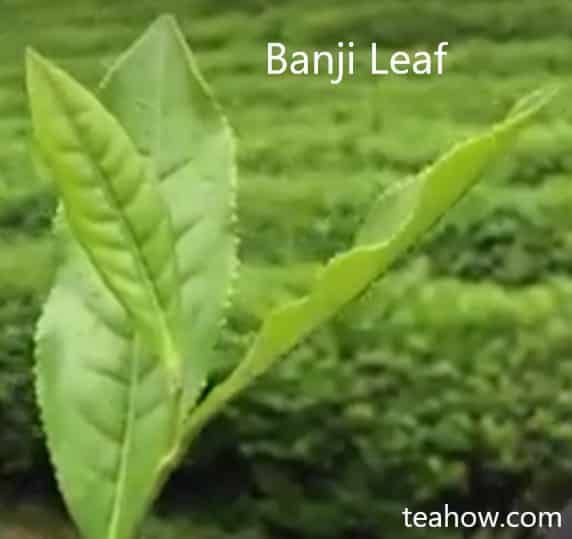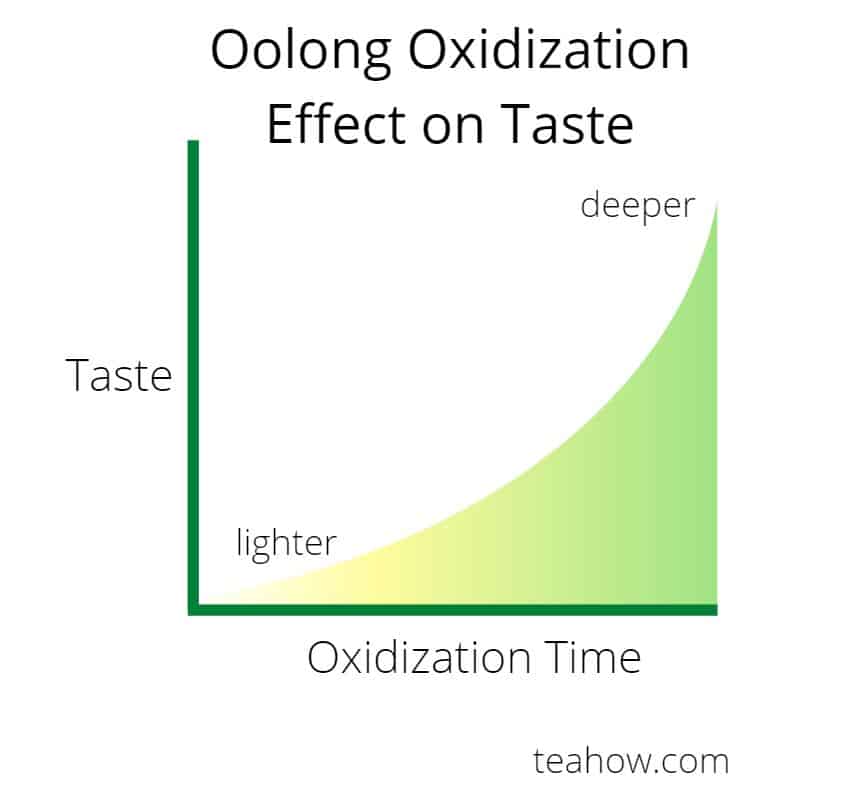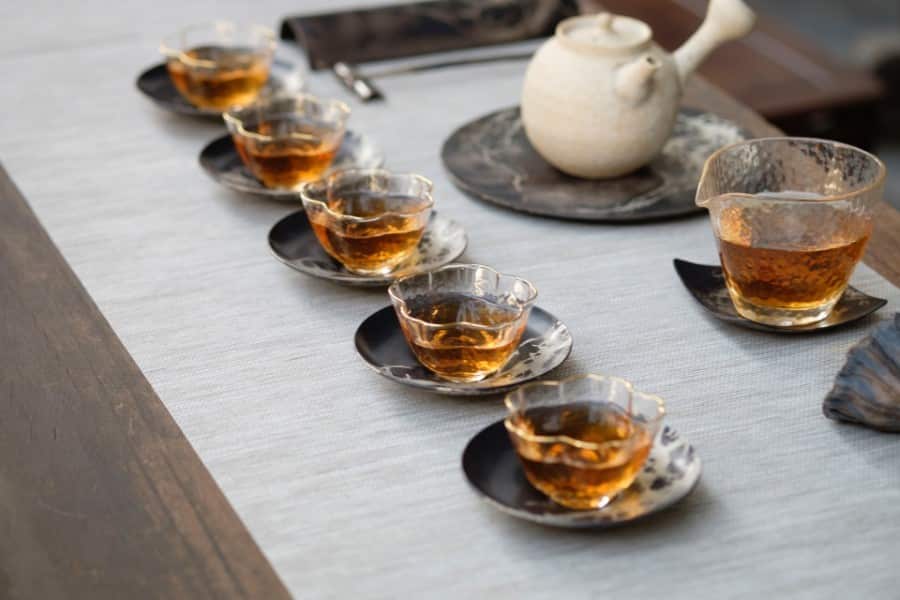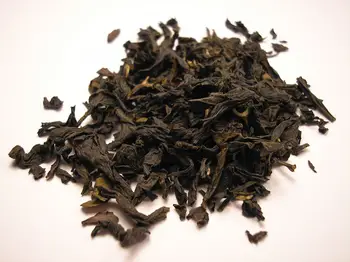Tough times call for some rightful pampering with a little self-care, delicious food, and a good ol’ cuppa tea!
Let me tell you, we’d be more than happy to give you legitimate advice in all three of those departments but today we’ll talk about our favorite – Oolong tea.
If you’ve heard little to nothing about this wonder tea, you’ve landed in the perfect place! When it comes to the best Oolong Tea, this article will tell you everything about the humble impresser i.e. Oolong tea.
If you just want to get your hands on some of the best Oolong, then just buy the teahow recommended Oolong here. Otherwise, to set this topic up, let’s just recap on what Oolong Tea is…
What is Oolong Tea?
With just the right amount of grace from Green tea and feistiness from Black tea, Oolong sits comfortably between the two variants in terms of appearance, aroma, taste, and health benefits.
While all three are made from leaves of the Camellia sinensis plant, essentially the differentiating factor is really the amount of oxidation the leaves undergo.
The popular Green tea is minimally oxidized, while Black tea goes through heavy oxidation. Oolong goes through anything between 8-80% oxidation allowing it to cover a plethora of tastes, aromas, and appearances similar to the extensive, flavorsome variants of the best herbal teas.
As you probably guessed, this also means Oolong imbibes the benefits of both Green and Black tea. Falling between the two also means Oolong has a moderate level of caffeine – making it a tea that can be enjoyed at any time of day.
We’d say that’s as close to perfection as it gets!
Finding its origins in Fujian and other regions of Southeast Asia, Oolong or Wu long tea has undeniably gained popularity, especially among tea connoisseurs – due to the diversity in the overall experience it provides.
Beautiful varieties of Oolong tea are also grown in India – specifically in regions of Bihar and Darjeeling giving them a unique, local flavor.
Good things take time and it’s no different with Oolong tea. Given the wide range of oxidation levels and exposure to the sun, it becomes challenging in terms of time, labor, and skill to make the perfect batch.
The preparation of Oolong tea is an extensive, careful process that involves the following steps
Oolong processing steps
Harvesting – Mostly made from the banji leaf, critically, it involves getting the right timing during the season and harvesting the leaf at just the right stage. Also, note that not all Oolong tea is made from the banji leaf
Withering – Withering is the process of wilting and beginning to dry the banji – Oolong leaves. Exposing to plenty of sunlight will decrease withering time by helping to dry and soften the leaf.
Tumbling – Once withered sufficiently, the banji leaf is then bruised and ruptured in a process that involves turning the leaves in a dedicated machine. This enables the phytonutrients to combine and mix.
Oxidation – Oxidization greatly affects both texture and taste when it comes to Oolong tea. A reaction occurs during these processes in which the polyphenols contained in the leaf become exposed, this causes mixing and reaction effect with juices – namely water, oxygen as a catalyst, and enzymes.
Oven or Pan Heating – Heat is critical to ceasing the oxidization process at just the right point. The flavor, texture, and fluid content will be locked in at this point. Oolong tea is oxidized for a longer period than green tea, but shorter than black tea.
Rolling – Following oxidization, the leaf must now be mixed and pushed together so as to combine all the flavor evenly through the leaf. This is done by a dedicated rolling machine, or by traditional hand-rolling. This process also helps form the leaves into their eventual rolled balls or spiral shapes.
Compression – An element of crushing and squashing must then take place, the rolled-up leaves are pushed firmly into a fabric sack and twisted and compressed down further by another machine. This also helps with the shaping process.
Drying – Additional evaporation takes place when the leaves are heated once more. This serves to maintained it’s shape and flavor composition as well as offer longevity to the leaf for storage purposes.
Roasting (optional) –.This is an additional step to enhance the richness of flavor, the overall body, and texture further. Now performed mostly by machine, but was traditionally done with hot charcoal embers.

Banji Leaf
It’s a labor-intensive process, but Oolong tea is well worth the wait. The complex flavor profiles it delivers are phenomenal and absolutely rewarding.
Wulong Fact #1 – How to drink Oolong tea
Oolong tea is best enjoyed when slurped slowly – following which you must gently pull it through your teeth. This method, which is recommended and practiced by tea experts allows you to absorb the aroma of the tea better. At first, this can feel strange, but it does give you the best Oolong tea experience. Trust me!
So now let’s get real personal with Oolong tea!
Best Oolong tea – flavor and aroma
With its wide range of processing and aging comes an assortment of tastes.
To put it simply, the lesser it is oxidized, the lighter the taste, and the more oxidized it gets, the deeper the flavor.
Here’s a visual way of looking at the oxidization effect on Oolong tea…

The leaves of this tea are rolled horizontally into needles or tightly into balls. The best characteristic of Oolong tea is that the same leaf rolled differently also produces different and distinct flavors that are subtle yet very complex.
Generally, Oolong teas from Taiwan tend to be lighter in color as well as flavor. This Oolong, when steeped, has creamy, floral, and gentle notes that linger for the perfect amount of time in the mouth.
The variants from other regions of Southeast Asia are usually processed longer – resulting in deeper notes and appearance.
Such Oolong teas have rich notes of nutty, smoky, chocolaty flavors that are beautifully enveloped in a delicate aftertaste of fruit.
| Oolong Production Location | Taste Profile |
| Taiwan | Creamy, floral, gentle notes |
| Southeast Asia | Rich, nutty, smoky, chocolaty |
The aroma of Oolong tea is simply an extension of its appearance and flavor.
The loose-leaf teas provide complexity in the aroma that complements the tea so perfectly that it becomes almost impossible to stop at a single cup.
Some of the best Oolong teas boast an overall nutty, deep aroma with a subtle smell of citrus and sandalwood while some varieties also have a strong fruity or sweet aroma.
Certain types of Oolong such as the Indian variants smell strong enough to fill up the room with the wonderful blend of fragrances making it a real wholesome tea experience.
“The aroma of Oolong tea is simply an extension of its appearance and flavor”
Best Oolong Tea – Storage
Oolong tea is typically stored in a non-glass airtight container.
Glass containers allow sun rays to penetrate through them thus causing damage to the tea leaves. Although best stored in a cool, dark place, this tea can also be refrigerated in an airtight container to keep it extremely fresh for longer.
Most teas can be stored for up to 2 years. However, the best Oolong teas are naturally the loose-leaf kind – of which the leaves are completely dried out.
This means Oolong tea doesn’t really spoil at all! In fact, over time, the flavors become deeper and nuttier given the slow but steady oxidation that continues to occur.
So even though Oolong teas tend to be slightly more expensive, there’s a lot of diversity and versatility they can offer …making this tea even more unique.
Wulong fact #2 – Oolong storage tip
Oolong tea can be aged for up to 40 years. The taste of these teas can be extremely rich and deep, finished off perfectly with a fruity taste of dried plums. Just like wine or cheese, Oolong does in fact get better with age. We’re not surprised at all…this tea just keeps impressing!

So now, we’re excited to share with you our top picks for the best Oolong teas. So here they are – the best Oolong teas:-
6 Best Oolong Teas
We’ve loved and researched, searched and filtered, tried, and tested and we’re presenting to you our picks for the 6 best Oolong teas!
1. Tieguanyin Oolong by Oriarm Tea Shop
Tieguanyin is an indigenous variety of tea originating from the Anxi county of Fujian.
Undoubtedly the pioneer of Oolong tea history, Tieguanyin is a particular favorite among tea aficionados for its flavor and freshness.
Some of the finest, best Oolong teas come from Fujian. The authentic teas, however, are found less frequently nowadays due to the growing popularity of other variants of Oolong tea.
Boasting beautiful emerald hues, the Tieguanyin Oolong tea by Oriarm Tea Shop is a delight in every sense of the word.
This tea is less oxidized, therefore drawing similarities in flavor and appearance to Green tea. Starting off with the taste of fresh green leaves, it has a light floral and whipped taste closing with a lingering taste of sweetness.
Oriarm has other varieties of tea too and they’re kind enough to let you choose samples with your order.
2. Giddapahar Wonder Oolong by TeaSwan Tea Company
Giddapahar is a small village in Darjeeling, India. During the British rule in India, Darjeeling happened to be the first region where tea plants were sown. So if you’re looking for some original source of tea history then this is the one to get.
Needless to say, the promising altitude, temperature, and soil produces excellent tea and makes Darjeeling a favorite among tea lovers.
Giddiapahar tea estate produces premium Oolong tea in very small quantities every year thus keeping intact the quality of the tea.
The Giddapahar Oolong available from the TeaSwan Tea Company is the best Oolong gets. All the tea leaves are hand-rolled to perfection producing a malty, almost spicy flavor.
Seamlessly switching between flavor profiles, this dark-leaved tea also has ultra-fine notes of chocolate combined with a perfect fruity, citrusy essence.
TeaSwan undeniably has the highest quality tea you can find. A passionate brand that sources only the best tea ethically, these guys are really taking tea to the next level!
3. Organic Milk Oolong by Yan Hou Tang Tea Industry
Yet another beautiful Oolong tea from Taiwan, Milk Oolong tea is as good as it sounds! Taiwanese tea is kept very natural and organic.
With no alterations to the soil, water, and other conditions, these tea enthusiasts are always willing to put in the work to attain supreme quality.
The native conditions add character and depth to the flavor of the tea leaves following which the locals minimally process them for a superb by product.
Yan Hou Tang is an original Taiwanese brand that works very closely with the locals to create their teas.
The milk Oolong they produce gives us three levels of creamy flavors with every consecutive infusion. Starting with buttery notes, the second steep gets more intensely milky whereas the third steep has a light, earthy flavor. One teaspoon, 3 hits, limitless elation…that’s a jackpot right there!
4. Green Ginseng Taiwan Oolong by TenRen’s Tea
Taiwan has a rich history of tea production and over the years these highly skilled tea lovers have perfected their products.
Strikingly different from the darker alternatives, loose-leaf teas from Taiwan tend to be less oxidized – thus retaining their beautiful green color.
Among other teas grown in Taiwan, the most popular exported kind is Oolong tea and you’ll definitely know why when you taste this gem of an Oolong.
TenRen’s tea chooses the best leaves from the best sources.
Their Taiwan tea is light, floral, and creamy – thus allowing a single sip to linger for a long time. TenRen also adds Ginseng to their tea to not only enhance the anti-inflammatory, antioxidant properties but also to add an exquisite aftertaste.
The velvety flavor of the tea leaves and the slightest hint of bitterness from Ginseng strike an impressive balance that you’ll thoroughly enjoy.
5. Doke Rolling Thunder Oolong by TeaSwan Tea Company
This tea is cultivated and harvested in the Indian state of Bihar. A family-run tea estate who is self-admittedly obsessed with tea, they sow only 4 varieties of tea making sure every plant is nurtured carefully.
These tea plantations are at sea level and situated immediately adjacent to the Doke river allowing the freshwater to run by the tea plants …which definitely adds more character to them.
The Doke rolling thunder Oolong tea at TeaSwan imbibes all the perfect flavors of a dark tea. The sweet and woody flavors finished with a gentle caramel aftertaste truly elevate the tea experience.
With a higher level of caffeine, this tea is ideal for a quick pick-me-up. The goal of TeaSwan is simply to produce the best Oolong tea.
6. Black Dragon Oolong by The Tao of Tea
Beautiful green, elliptical Oolong leaves adorn the mountains at Anxi. Planted atop rocks, along the slopes of the mountainous regions.
These plants get the perfect amount of freshwater and sunlight which enhances the quality of the leaves tenfold.
The variants of this tea are sometimes unroasted to show off the originality in appearance and taste.
The tight hand-rolled Oolong by The Tao of Tea is one of the best sellers.
This company keeps it real too and delivers only fresh, premium quality tea. The tea leaves are roasted and then re-roasted to amplify the dark, nutty taste and smell.
The finish of this tea is perfectly well rounded and presents a fine array of flavors. The leaves carry such a diverse abundance of tastes that every single sip will surprise and impress you.
Wulong fact #3 – Oolong flavor
Although Oolong tea is traditionally enjoyed plain, people love to pair it with milk. The compound flavors of the leaves integrate seamlessly with the smooth, creamy flavor of milk resulting in a whole different experience. Oolong with milk isn’t for everyone though. But, as they say …to each their own.
Now that you’ve bought your tea from one of the Oolong teas listed above, let’s move on to how to make Oolong Tea
How to make Oolong tea?
The medley of flavors in Oolong tea allows a lot of flexibility in terms of preparation.
So you most definitely don’t need an elaborate Gongfu tea ceremony to enjoy the first-class experience this tea has to offer.
Having said that, you most certainly shouldn’t hold back when it comes to tea either.
If you have a fancy tea set, we’d recommend you flaunt it. Not only when you’re entertaining but also when you’re on your own simply enjoying your little cup of joy!
Pair your Oolong with some honey, raw sugar, milk, lemon, or just plain. The options are endless and this tea, timeless.
So here are the basic steps to prepare and dive into a soothing cup of Oolong tea:
Basic steps to make Oolong tea:
- To experience the real flavors and intricacies of Oolong, we’d suggest you ditch teabags and get yourself the real deal – loose leaf teas. They last longer, contain zero micro and nano plastic, they’re environment friendly and most importantly, they taste authentic.
- Add about 1 teaspoon (4 grams) per cup of the tea leaves to the steeper (internal or external).
- Boil (~190ºF) clean water. You will know it’s the right temperature when you see intense bubbling.
- Rinse the teapot with just a little boiling water.
- Rinse the tea leaves in your steeper with a little boiling water. You will simply add about 10 ml of the boiling water to your tea leaves, give it a gentle swirl, and pour out the water immediately. This step gets rid of small debris or dust particles in your tea leaves.
- Add the boiling water to your teapot that contains your leaves until the leaves are fully immersed.
- Let the leaves infuse for up to 3 minutes. You will see the tightly rolled Oolong leaves slowly unfurl. Definitely spend a moment to admire the beauty of this process when the leaves slowly unravel …starting to look like little black dragons (which happens to be another popular name for Oolong tea).
- Pour the hot infused water to a cup and slurp away!!
Tips
- Steps 4 and 5 are completely optional. Perhaps you could save them for special days when you’re not such a busy bee!
- Green, lighter-colored leaves produce a faint green or yellow tea whereas darker leaves produce a vibrant orange or deep rust color.
- You can repeat infusions with the same set of leaves for up to 5 times. The continued uncurling of the leaves together with repeated dilutions produce different flavor and scent each time.

Our personal favorite accompaniments with Oolong tea – when we’re not drinking it plain – are almond cookies, coconut macaroons, dark chocolate, honey, or lemon.
Wulong fact #4 – Oolong pricing
Anxi county of Fujian province is a trailblazer when it comes to the best Oolong tea production. Today one of the most expensive, pure variety from this region is sold at $19,000 for 500 grams (at the time of writing).
Health benefits of Oolong tea
The wide array of health benefits we gain from tea is not surprising. Primarily though, the Polyphenols present in tea are the main ingredients that provide all the magic.
Spoken greatly by Japanese centenarians, a modest diet combined with tea seems to be the secret to achieving a long, healthy life.
Although Green tea is spoken of highly in terms of benefits …due to its abundant antioxidants, the similarity Oolong tea has with Green tea results in similar beneficial properties.
The partially oxidized Oolong tea retains a lot of the anti-oxidants which are otherwise lost with excessive fermentation. This property also controls caffeine content in Oolong making it an ideal drink – that isn’t restricted to time.
Combats free radicals
One of the primary reasons for cellular senescence is the accumulation of free radicals in the body. Antioxidants like polyphenols found in plants combat free radicals to maintain cellular homeostasis. This results in the prevention of aging thus explaining the age-old Japanese practice of frequent tea consumption.
Oolong tea promotes weight loss
Bioactive compounds present in tea have a Hypolipidemic effect, meaning a steady decrease in body fat.
Although the molecular mechanism is not completely elucidated, experiments have shown between 10 – 18% weight loss as well as a decrease in total cholesterol, LDL-C levels. (1). A recent study has also shown Oolong tea to be the most effective for weight loss (2).
Caffeine present in Oolong tea is said to promote lipolysis (fat breakdown) in the body which can effectively reduce obesity. Although inconclusive, there have been hundreds of studies on weight loss due to Oolong tea.
A significant fraction of research suggests the positive effects of this tea on body fat weight.
Other benefits of Oolong tea
The significant hypoglycemic effect of polysaccharides and antioxidants contained in Oolong tea show promising results in the reduction of blood sugar levels.
Varying amounts of tea consumption per day showed different levels of stability.
Increased free radicals or ROS in the body can cause substantial damage to DNA thus resulting in a mutation.
The consequence being serious and potentially leading to cancer. To neutralize such large amounts of free radicals, the introduction of external antioxidants becomes crucial.
High levels of antioxidants present in Oolong tea help may help in this case too. (3)
Even though more irrefutable data is essential, some very conclusive observations regarding the benefits of Oolong tea in terms of aging, oral health, bone strength are already present.
This is definitely reason enough to introduce Oolong tea into our diets. No matter what flavor and caffeine strength one prefers, Oolong tea has something for everyone.
Wulong fact #5 – Oolong for Boba tea
The flexibility in flavor Oolong tea offers makes it a classic choice for Boba tea (Bubble tea) in Taiwan. Taiwanese people prepare this delicious drink using freshly infused Oolong tea, milk, and Boba pearls. If you’re a bubble tea lover, don’t miss out on this wonder!
Wrapping up
As you can probably tell, we share a deep passion for Oolong tea and we can’t stop talking about it…clearly. But it is what it is because this tea is in a league of its own!
The rich history, flavor, aroma, and variety – combined with the conspicuous health benefits make Oolong a hearty, wholesome experience.
We can’t help but pass on our love, and admiration for this tea to you and we truly hope this tea makes you happy.
Now that we’ve shared our list of the best Oolong teas available, we’re sure you’ll find your favorites. Snuggle up with a hot cup of Oolong because it’s always time for tea, and there’s always room for Oolong tea.
About the author
Sindhuja Bheesette is an avid tea lover and particularly enjoys the authentic, delicate flavors the beverage offers. Making the switch about 5 years ago from the convenience of teabags to the premium experience of loose leaf teas, she is amazed by the complexity of this modest drink. Having completed her Bachelor in Biology, Sindhuja is interested in understanding how food affects metabolism and overall health in humans.
